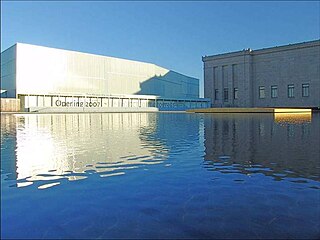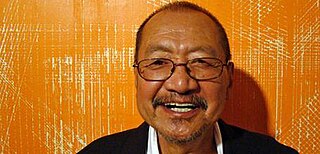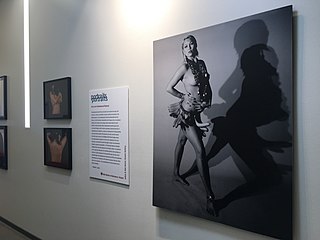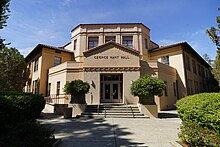
The Nelson-Atkins Museum of Art is an art museum in Kansas City, Missouri, known for its encyclopedic collection of art from nearly every continent and culture, and especially for its extensive collection of Asian art.

Rudolph Carl Gorman was a Native American artist of the Navajo Nation. He was referred to as "the Picasso of American Indian artists" by The New York Times, and his paintings are primarily of Native American women and characterized by fluid forms and vibrant colors, though he also worked in sculpture, ceramics, and stone lithography. He was also an avid lover of cuisine, authoring four cookbooks, called Nudes and Food.

The Eiteljorg Museum of American Indians and Western Art is an art museum in downtown Indianapolis, Indiana, United States. The Eiteljorg houses an extensive collection of visual arts by indigenous peoples of the Americas as well as Western American paintings and sculptures collected by businessman and philanthropist Harrison Eiteljorg (1903–1997). The museum houses one of the finest collections of Native contemporary art in the world.

The Institute of American Indian Arts (IAIA) is a public tribal land-grant college in Santa Fe, New Mexico, United States. The college focuses on Native American art. It operates the Museum of Contemporary Native Arts (MoCNA), which is housed in the historic Santa Fe Federal Building, a landmark Pueblo Revival building listed on the National Register of Historic Places as Federal Building. The museum houses the National Collection of Contemporary Indian Art, with more than 7,000 items.

Hulleah J. Tsinhnahjinnie is a Navajo Nation photographer, museum director, curator, and professor. She is living in Davis, California. She serves as the director of the Gorman Museum of Native American Art and teaches at University of California, Davis.

Benjamin Alfred Haldane was a Tsimshian professional photographer from Metlakatla, Alaska.

Carlos Villa was a Filipino-American visual artist, curator and faculty member in the Painting Department at the San Francisco Art Institute. His work often explored the meaning of cultural diversity and sought to expand awareness of multicultural issues in the arts.
Frank Tuttle is a contemporary Native American artist. He is from the Yuki people, Wailaki and Concow Maidu Native communities.

Erica Lord is an Alaska Native artist, based in Santa Fe, New Mexico, who identifies herself as a mixed-race "cultural limbo."

Wendy Red Star is an Apsáalooke contemporary multimedia artist born in Billings, Montana, in the United States. Her humorous approach and use of Native American images from traditional media draw the viewer into her work, while also confronting romanticized representations. She juxtaposes popular depictions of Native Americans with authentic cultural and gender identities. Her work has been described as "funny, brash, and surreal". Red Star was awarded a MacArthur Fellowship in 2024.
Jean LaMarr is a Northern Paiute/Achomawi artist and activist from California. She creates murals, prints, dioramas, sculptures, and interactive installations. She is an enrolled citizen of the Susanville Indian Rancheria.

The Manetti Shrem Museum of Art is a fine arts museum located at the University of California, Davis in Davis, California. Its full name is the Jan Shrem and Maria Manetti Shrem Museum of Art.
D.Y. Begay is a Navajo textile artist born into the Tóʼtsohnii Clan and born from the Táchiiʼnii Clan.
Duane Slick is a Meskwaki artist and educator of Ho-Chunk descent. He is known for his monochromatic paintings. He has taught fine arts at Rhode Island School of Design (RISD) since 1995.
George Chester Longfish is a First Nations artist, professor, and museum director. His art work blends Pop art with Indigenous motifs, and often features assemblage. Many of his works have been featured in major public museum exhibitions, including the Heard Museum, and the Smithsonian's National Museum of the American Indian. He was a professor of Native American Studies at the University of California, Davis, for almost 30 years. He served as the museum director at the C.N. Gorman Museum at U.C. Davis, from 1974 to 1996.
Melissa Melero-Moose is a Northern Paiute/Modoc mixed-media artist and co-founder of Great Basin Native Artists, a collective based in Nevada. She is enrolled in the Paiute-Shoshone Tribe of the Fallon Reservation and Colony.
Frank Raymond LaPena, also known as Frank LaPeña and by his Wintu name Tauhindauli, was a Nomtipom-Wintu American Indian painter, printmaker, ethnographer, professor, ceremonial dancer, poet, and writer. He taught at California State University, Sacramento, between 1975 and 2002. LaPena helped defined a generation of Native artists in a revival movement to share their experiences, traditions, culture, and ancestry.

Carl Nelson Gorman (1907–1998), also known as Kin-Ya-Onny-Beyeh, was a Navajo code talker, visual artist, painter, illustrator, and professor. He was on the faculty at the University of California, Davis, from 1950 until 1973. During World War II, Gorman served as a code talker with the United States Marine Corps in the Pacific.










